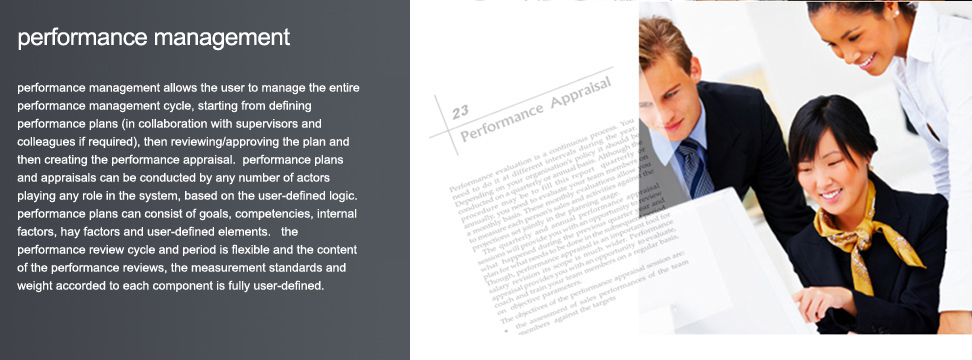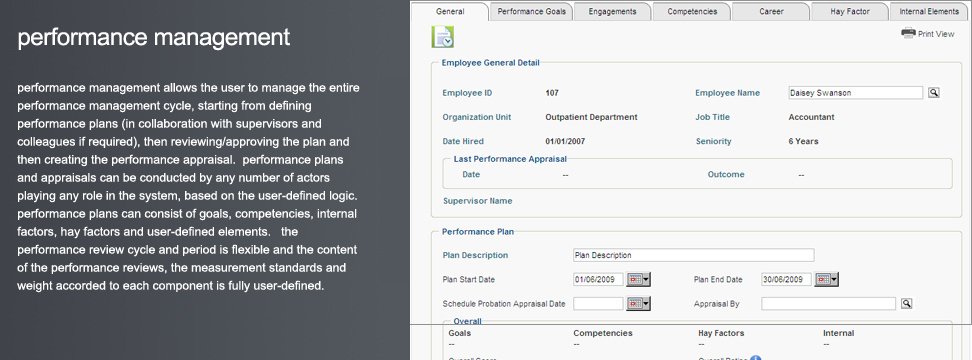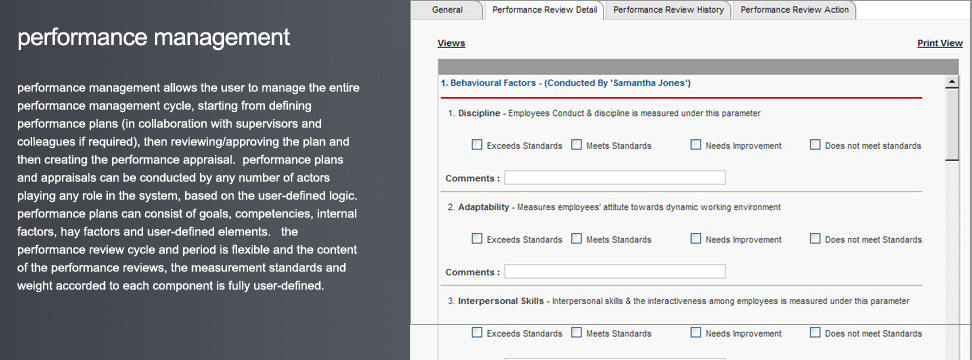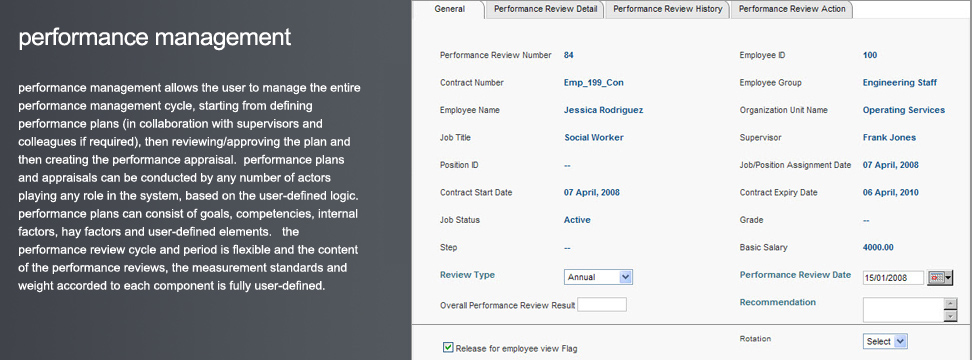 Performance Management |
Interact HRMS Performance Management Module Overview
The Performance Management module in Interact HRMS is a comprehensive 360-Degree Performance Evaluation System that allows organizations to design, implement, and manage goal-based performance appraisals tailored to various job roles, departments, and projects. Built around User-Defined Dimensions and Factors, the module supports a flexible evaluation framework that aligns with organizational goals, employee competencies, and career development paths. Through Performance Plans and Engagement Plans, employees are assessed based on goals aligned with organizational objectives, enabling data-driven decision-making for training, promotions, and career planning.
Ideal for organizations aiming to customize and automate their performance management process, this module integrates seamlessly with Career Planning, Training Management, Competencies Management, Succession Planning, and Compensation Management. By defining appraisal cycles, assigning multiple evaluators, and leveraging workflows for notifications and approvals, the Performance Management module provides a structured, holistic approach to evaluating and developing employee performance.
Goal-Based Performance Planning and Appraisal
The core of the Performance Management module is Goal-Based Appraisal, where the first dimension is the Employee Performance Plan, outlining specific goals that align with the organization’s annual objectives. This alignment ensures that each employee’s performance directly contributes to achieving organizational targets. Employees are evaluated on their achievements against these predefined goals, supporting a transparent and measurable appraisal process.
For instance, a sales employee may have a performance plan focused on meeting specific revenue targets. By assessing achievements against these goals, the organization can clearly measure individual contributions to the overall success of the business.
Multi-Dimensional Evaluation with Customizable Factors
In addition to goal-based performance, the module supports Multiple Evaluation Dimensions and factors, such as Competencies, Hay Factors, and Internal User-Defined Elements. Each dimension includes associated factors that are critical for assessing an employee’s overall contribution and effectiveness. This flexibility allows organizations to tailor the performance evaluation model to capture the competencies and behaviors most relevant to each role.
For example, an engineering position may include dimensions such as technical competencies, collaboration skills, and adherence to project timelines. By including multiple dimensions, the module ensures that evaluations cover all aspects of job performance, promoting a well-rounded assessment process.
Automated Performance Evaluation Forms with Multiple Evaluators
The module generates Performance Evaluation Forms with sections assigned to different evaluators. Each evaluator assesses specific aspects of an employee’s performance, allowing input from multiple perspectives. This 360-Degree Evaluation approach provides a balanced view, with contributions from supervisors, peers, and other stakeholders, improving objectivity and fairness in evaluations.
For example, a manager might assess an employee’s goal achievements, while a peer could evaluate teamwork skills. This multi-evaluator setup fosters a comprehensive review and supports a collaborative approach to performance management.
Flexible Appraisal Cycles and Project-Specific Engagement Plans
The Performance Management module supports Flexible Appraisal Cycles, including standard intervals (Monthly, Quarterly, Yearly) and custom cycles tied to projects or specific milestones. In addition to regular performance reviews, Engagement Plans can be created for employees working on specific projects or client assignments, ensuring that project-based performance is evaluated independently of standard job performance.
For instance, a consulting employee’s performance on a high-profile project can be reviewed upon project completion, providing detailed feedback on project-specific goals and client interactions. This flexibility supports customized performance tracking, ensuring accurate assessments for both ongoing roles and temporary assignments.
Self-Service for Employee and Supervisor Participation
Through Self-Service, employees, supervisors, and managers can access and contribute to the performance review process. Employees can create their Performance Plans, while supervisors and managers review, edit, and approve these plans. This collaborative approach allows all parties to actively engage in setting and achieving performance goals, fostering ownership and accountability.
For example, an employee may draft a performance plan with goals for skill development and productivity, which their supervisor then reviews and finalizes. This shared responsibility in goal-setting ensures alignment with both organizational and personal career objectives.
Customizable Performance Model Setup
The module allows organizations to define a Performance Model tailored to their specific evaluation framework, choosing dimensions such as Goals, Competencies, Career Factors, Hay Factors, and other custom elements. This setup enables users to configure the system to reflect existing appraisal methods, ensuring that performance evaluations are consistent with the organization’s standards and processes.
For example, a company might set up a model emphasizing goal achievement and professional growth, with dimensions for skill development and cross-functional collaboration. By customizing the performance model, the organization ensures that evaluations align with both internal requirements and industry best practices.
Integration with Career Development and Succession Planning
The Performance Management module integrates seamlessly with Career Planning, Training Management, and Succession Planning, enabling specific actions based on appraisal outcomes. Following a performance review, actions such as Training, Career Planning, New Job Assignments, On-the-Job Training, Coaching, and Promotions can be initiated. This integration ensures that performance evaluations drive meaningful career progression and development.
For instance, an employee who demonstrates leadership potential in their appraisal may be placed on a career track for management, with corresponding training and mentorship opportunities. This holistic approach ensures that performance results translate into actionable career development.
Defined Performance Standards and Measurement Parameters
The module allows organizations to create Performance Standards that apply across all parameters in the evaluation model. Users can define measurement standards for consistency in scoring and performance rating across different roles and departments, ensuring a unified approach to evaluating performance.
For example, all roles may use a standardized 1–5 rating scale to measure goal achievement, making it easy to compare results across departments. This standardized approach enhances objectivity and ensures that performance is measured consistently across the organization.
Goal Grouping and Weighting for Enhanced Evaluation Clarity
The module enables Grouping of Performance Goals within Performance Goal Groups, each with specific weights and scoring standards. This setup allows organizations to prioritize certain goals over others within each evaluation dimension, supporting a clear and organized appraisal process.
For instance, a performance goal group for “Customer Service” may be weighted higher for a client-facing role, emphasizing its importance. This prioritization allows evaluators to focus on the most impactful goals, ensuring that performance assessments reflect the role’s true requirements.
Real-Time Updates and Color-Coded Performance Plans
Performance plans display pre-defined goals under their relevant groups, with Color Coding to distinguish goals and quickly identify areas of focus. This feature allows users to visualize performance plans, making it easy to distinguish between different goal types and levels of priority.
For example, goals related to productivity may be color-coded green, while development goals appear in blue. This visual organization improves clarity for both employees and evaluators, supporting a streamlined review process.
Workflow-Enabled Appraisal and Notification System
The Performance Management module includes a Workflow and Notification System to automate the appraisal process. Notifications prompt evaluators to review and approve performance plans, ensuring timely evaluations. This workflow-based approach also manages appraisal approvals, maintaining accountability and compliance throughout the process.
For instance, when a performance appraisal is due, the system sends notifications to the assigned evaluators, prompting them to complete their review. This automation streamlines the appraisal cycle and ensures that all evaluations are completed in a timely manner.
General Features of the Performance Management Module
- Goal-Based Performance Planning: Define and evaluate goals aligned with organizational objectives.
- Multi-Dimensional Evaluation Framework: Customize evaluation dimensions and factors for comprehensive assessments.
- Automated Evaluation Forms with Multiple Evaluators: Assign different evaluators to assess various performance dimensions.
- Flexible Appraisal Cycles and Engagement Plans: Set custom appraisal cycles and project-based engagement plans.
- Self-Service for Employees and Supervisors: Enable active participation in goal setting and performance plan management.
- Customizable Performance Model: Design tailored performance models based on organizational standards.
- Integration with Career Development and Training: Drive career planning and skill development based on appraisal outcomes.
- Defined Performance Standards: Apply consistent measurement standards across all evaluation parameters.
- Goal Grouping and Weighting: Organize goals within weighted groups for focused evaluations.
- Color-Coded Performance Plans: Use visual cues for easy navigation and focus during performance reviews.
- Workflow and Notification System: Automate appraisal tasks and prompt timely reviews with notifications.
Summary: Interact HRMS Performance Management
The Interact HRMS Performance Management module offers a structured, integrated approach to performance evaluations, supporting employee development and organizational alignment. Key benefits include:
- Goal-Based Evaluation Aligned with Organizational Objectives: Set and assess goals that align with annual organizational plans.
- Customizable Multi-Dimensional Framework: Define various evaluation dimensions tailored to role-specific needs.
- Automated 360-Degree Evaluation: Use forms with multiple evaluators for a balanced and objective appraisal process.
- Flexible Appraisal Cycles and Project Engagement Plans: Choose standard or custom cycles, with project-based evaluations when needed.
- Self-Service for Goal Setting and Appraisals: Facilitate employee and supervisor participation in the evaluation process.
- Integrated Career and Succession Planning: Translate appraisal outcomes into actionable development and career progression steps.
- Standardized Performance Measurement: Apply consistent rating standards across roles and departments for fair assessments.
- Organized Goal Grouping and Weighting: Prioritize and weigh goals to focus on the most critical aspects of performance.
- Workflow-Enabled Notifications and Approvals: Automate the appraisal process with a structured workflow and timely notifications.
By combining these features, the Performance Management module empowers organizations to design and manage performance evaluations that are tailored to their unique standards and strategic goals. This structured approach to performance management enhances employee engagement, supports career development, and ensures that individual contributions align with organizational success.




